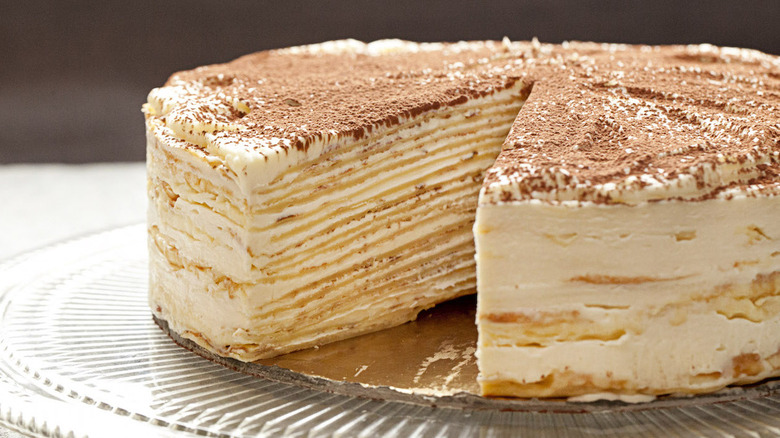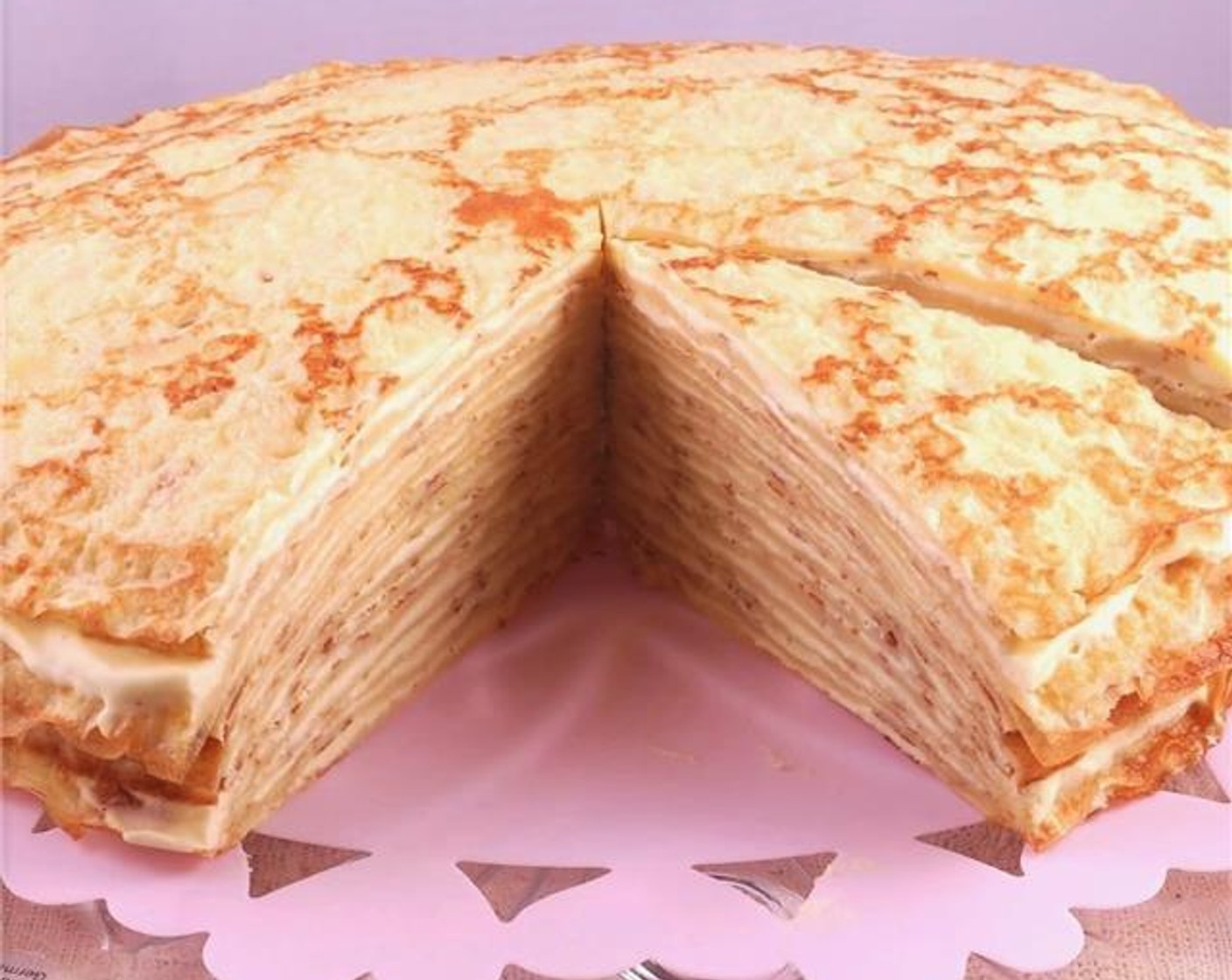The French Mille Crepe is a classic dessert that is both delicious and elegant. It is made with layers of thin crepes that are filled with a variety of fillings, such as pastry cream, chocolate ganache, or fruit. The result is a dessert that is light and airy, yet rich and flavorful.
In this blog post, we will share our recipe for the French Mille Crepe. We will also provide tips on how to make the perfect crepes, as well as how to assemble and fill the cake. So whether you are a novice baker or a seasoned pro, we encourage you to give this recipe a try.
We promise that you will not be disappointed!
Ingredients
Mille crepe, a classic French dessert, requires a precise blend of ingredients to achieve its delicate and flavorful layers. Understanding the key components and their significance is crucial for creating an authentic and delectable mille crepe.
The primary ingredient is flour, which forms the base of the crepes. High-quality all-purpose flour provides a neutral flavor and the right balance of gluten, allowing for thin and pliable crepes. Butter adds richness and flavor, while milk provides moisture and helps create a smooth batter.
Eggs act as a binder, giving the crepes structure and holding the layers together.
Specialized Ingredients
In addition to these core ingredients, mille crepe often incorporates specialized ingredients that enhance its flavor and appearance. Crème pâtissière, a rich and creamy custard, is spread between the layers, providing a velvety texture and a sweet contrast to the crepes.
Grand Marnier, an orange-flavored liqueur, is sometimes added to the custard for a subtle citrusy aroma.
Method
Crafting the delectable French Mille Crepe demands meticulous attention to detail. Each layer, meticulously prepared and carefully assembled, contributes to the symphony of flavors and textures that define this culinary masterpiece. The following guide will lead you through the intricate steps, empowering you to create an exceptional Mille Crepe that will tantalize your taste buds.
Preparing the Batter
Begin by whisking together the flour, sugar, and salt in a large bowl. In a separate bowl, whisk together the eggs, milk, and melted butter until smooth. Gradually add the wet ingredients to the dry ingredients, whisking constantly until a smooth, lump-free batter is achieved.
Allow the batter to rest for at least 30 minutes, which will allow the flour to fully hydrate, resulting in a more tender crepe.
Cooking the Crepes
Heat a lightly greased 8-inch crepe pan or skillet over medium heat. Pour a thin layer of batter into the center of the pan, swirling the pan to distribute the batter evenly. Cook for 1-2 minutes per side, or until the edges are golden brown and the center is set.
Transfer the cooked crepe to a plate and repeat with the remaining batter.
Assembling the Crepe
Once all the crepes are cooked, spread a thin layer of pastry cream or your preferred filling between each crepe. Stack the crepes on top of each other, pressing down gently to ensure they adhere. Refrigerate the assembled crepe for at least 4 hours, or overnight, to allow the flavors to meld and the crepe to set.
Finishing Touches
Before serving, dust the top of the crepe with powdered sugar or cocoa powder. You can also drizzle it with chocolate sauce or caramel sauce for an extra touch of indulgence. Slice and serve the Mille Crepe chilled, savoring each delectable bite.
Variations
The classic French Mille Crepe recipe is a versatile canvas for culinary creativity. Experiment with different flavor combinations, fillings, and adaptations to tailor it to special occasions or dietary needs.
From savory to sweet, the possibilities are endless. Explore some popular variations below:
Flavor Combinations
- Matcha Green Tea: Infuse the batter with matcha powder for a vibrant green hue and earthy flavor.
- Chocolate: Add melted chocolate to the batter for a rich and decadent variation.
- Citrus: Zest lemon or orange into the batter for a refreshing and tangy twist.
Fillings
- Classic Crème Pâtissière: Fill the crepes with a smooth and creamy custard filling.
- Fruit Compote: Spread a layer of fresh fruit compote between the crepes for a vibrant and juicy filling.
- Whipped Cream: Top the crepes with whipped cream for a light and airy filling.
Special Occasions
- Wedding Cake: Stack the crepes into a tall cake form and decorate with fresh flowers or edible gold leaf.
- Birthday Cake: Add sprinkles or candy to the batter and decorate with candles for a festive birthday treat.
Dietary Needs
- Gluten-Free: Use gluten-free flour to create crepes that are suitable for individuals with gluten intolerance.
- Vegan: Replace milk and eggs with plant-based alternatives to create a vegan-friendly version.
- Sugar-Free: Use sugar-free sweetener in the batter and filling to cater to those with dietary restrictions.
Presentation
The presentation of a French Mille Crepe is crucial to showcase its delicate layers and elegant appeal. Consider these plating and garnishing ideas to elevate your dessert:
Plating
Serve the Mille Crepe on a chilled plate to maintain its shape and prevent the layers from sliding. Arrange the crepe vertically or horizontally, depending on the desired visual effect. For a classic presentation, stack the layers vertically, allowing the intricate layers to be visible.
Garnishing
Sprinkle powdered sugar over the crepe to create a delicate dusting. This adds a touch of sweetness and enhances the visual appeal. You can also garnish with fresh berries, such as raspberries or blueberries, to add a pop of color and a burst of flavor.
Edible flowers, such as rose petals or violets, can also be used as a sophisticated and fragrant garnish.
Storing and Serving
Store the Mille Crepe in the refrigerator for up to 3 days. When ready to serve, bring it to room temperature for about an hour to allow the flavors to fully develop. Cut into individual slices using a sharp knife and serve immediately.
Historical and Cultural Context

The Mille Crepe, with its origins shrouded in the mists of time, is a culinary masterpiece that has captivated the hearts and palates of generations in France. This delectable pastry, crafted from countless layers of delicate crepes, has become an emblem of French cuisine, a testament to the nation’s rich culinary heritage.
Legend has it that the Mille Crepe was first conceived in the 17th century, in the kitchens of the illustrious Chateau de Chambord. As the story goes, a young pastry chef, eager to impress his demanding master, spent countless hours meticulously layering paper-thin crepes, creating a tower of pastry that reached towards the heavens.
The result was a symphony of flavors and textures, a culinary masterpiece that would forever bear the name “Mille Crepe.”Over the centuries, the Mille Crepe has undergone a remarkable evolution, adapting to changing tastes and culinary trends. From its humble beginnings as a simple dessert, it has transformed into a versatile delicacy, adorned with a myriad of fillings and toppings.
Today, the Mille Crepe is a staple of French patisseries, a symbol of tradition and innovation.
Tips and Troubleshooting
Mastering the art of crafting mille crêpes requires patience and attention to detail. Here are some tips and troubleshooting solutions to help you prevent common mistakes and achieve the perfect stack:
Preventing Common Mistakes:
- Batter too thick: Ensure the batter is thin enough to spread evenly in a thin layer.
- Pan too hot: Heat the pan over medium-low heat to prevent the crêpes from burning.
- Overcrowding the pan: Spread the batter thinly and evenly over the entire surface of the pan.
- Flipping too early: Wait until the edges of the crêpe are golden brown and the center is set.
- Tearing the crêpes: Use a thin spatula to gently lift the crêpes.
Troubleshooting Potential Issues:
- Crêpes sticking to the pan: Grease the pan lightly with butter or oil before pouring the batter.
- Crêpes breaking: Use a non-stick pan or season your pan well.
- Crêpes too thick: Thin the batter with more milk or water.
- Crêpes too thin: Thicken the batter with more flour.
- Filling too runny: Allow the filling to cool slightly before spreading it on the crêpes.
Adjusting the Recipe:
Depending on your skill level and available resources, you can adjust the recipe as follows:
- Beginners: Use a non-stick pan, start with a small amount of batter, and be patient.
- Advanced: Use a seasoned cast-iron pan and experiment with different fillings and flavors.
- Limited resources: Use a flat griddle or electric skillet instead of a traditional crêpe pan.
FAQs
Gather essential information about Mille Crêpe with these frequently asked questions and their concise answers.
This organized list addresses common queries, such as ingredient substitutions, cooking times, and serving suggestions, providing you with a comprehensive understanding of this delectable dessert.
Ingredient Substitutions
- Can I use a different type of flour?Yes, you can substitute all-purpose flour with cake flour or pastry flour, which may result in a more tender texture.
- What if I don’t have heavy cream?You can use milk or half-and-half instead, but the filling will be thinner.
- Is it possible to make the filling vegan?Yes, you can use a plant-based milk and cream alternative, such as almond milk and coconut cream.
Cooking Times
- How long should I cook each crêpe?Cook each crêpe for about 1-2 minutes per side, or until golden brown.
- What if my crêpes are too thick?Thin the batter with a little bit of milk or water.
- How do I prevent my crêpes from sticking to the pan?Make sure your pan is hot and greased before pouring in the batter.
Serving Suggestions
- What are some classic ways to serve Mille Crêpe?Traditionally, it’s served chilled with a dusting of powdered sugar or fresh fruit.
- Can I add different fillings to the crêpes?Yes, you can experiment with fillings such as chocolate ganache, fruit compote, or whipped cream.
- Is Mille Crêpe suitable for special occasions?Yes, its elegant appearance and delicious taste make it perfect for birthdays, anniversaries, and other celebrations.
Nutritional Information
The French Mille Crepe is a delectable pastry with a surprisingly rich nutritional profile. Despite its indulgent appearance, it offers a balance of macronutrients and notable vitamins and minerals.
Calorie Count and Macronutrient Composition
A single serving of French Mille Crepe (approximately 1/12th of the cake) contains around 350-400 calories. The macronutrient composition is primarily:
Carbohydrates
50-60%
Fat
30-40%
Protein
10-15%
Vitamins and Minerals
The French Mille Crepe also provides essential vitamins and minerals, including:
Vitamin D
Supports bone health and immune function
Calcium
Contributes to strong bones and teeth
Potassium
Regulates fluid balance and blood pressure
Iron
Essential for red blood cell production
Final Conclusion

We hope that you have enjoyed this blog post about the French Mille Crepe. We encourage you to give this recipe a try, and we are confident that you will love it. If you have any questions, please feel free to leave a comment below.
We would be happy to help!
FAQ Summary
What is the best way to make the crepes?
The best way to make the crepes is to use a non-stick pan and to cook them over medium heat. Be sure to spread the batter thinly and evenly over the pan, and to cook each crepe for only 1-2 minutes per side.
What is the best filling for a French Mille Crepe?
The best filling for a French Mille Crepe is a matter of personal preference. Some popular fillings include pastry cream, chocolate ganache, and fruit. You can also get creative and try your own unique fillings.
How do I assemble a French Mille Crepe?
To assemble a French Mille Crepe, simply spread a layer of filling between each crepe. Then, stack the crepes on top of each other, and finish with a layer of filling on top. You can then refrigerate the cake for at least 4 hours before serving.
